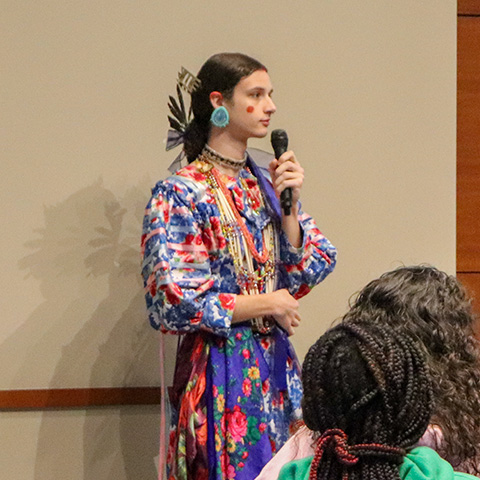Heather McCarty
An alumna of the Sociology & Anthropology and M.A. in American Studies programs penned an essay that explored Indigenous fashion, cultural identity and sustainability for the Stockton University Art Gallery's exhibition, "Indigenous Approaches, Sustainable Futures."
Click to hear Heather McCarty talk about her involvement with the Art Gallery's curatorial team and writing the essay that was featured in the exhibition's program.
#ElevateYourVoiceStocktonU

Native American Fashion as Resistance and Empowerment: Exploring Cultural Identity, Sustainability, and Economic Sovereignty
Indigenous design is the original design language of America, connected to this land and place."Amber-Dawn Bear Robe, 2022.
Fashion in today’s world is culturally significant and ever-changing. The beauty of fashion textiles is recognized worldwide as a uniquely creative lens into one’s cultural identity. Native American1 fashion, in particular, is fascinating, with a rich history reflected in contemporary works. As seen in indigenous material culture, honoring the past and familial ancestors plays a significant role in creating certain patterns and using specific techniques. These garments can serve multiple purposes, from protection against weather to storing materials, as tribes were nomadic. This can be a resistance to capitalism and fast fashion, which ultimately harm indigenous communities and their resources. Native American fashion serves as a form of resistance to capitalism through the preservation of cultural identity, promotion of sustainability, and pursuit of economic sovereignty.
The History of Native American Sustainable Fashion
Providing historical context is pertinent to fully understanding Native American culture and the fashion produced today. Traditional Native clothing has been researched for decades and dates back to the early 1700s. Native artists used raw materials locally sourced from the land and traded with neighboring tribes. Styles varied by tribe, as most indigenous people were nomadic and relocated frequently. Thus, garments and accessories served as protection from the weather, signifying ranks or positions within a tribe, and were sustainable and could be used repeatedly for a longer time.2 These textiles could also be fixed and renewed after long periods of use or made into a new item. Sustainability is a huge factor of Native American fashion, as it is defined as incorporating humans and nature to preserve the land by transforming the status quo. This is a challenging task, as it involves dismantling the whole economic system and shifting to non-capitalistic ways.3
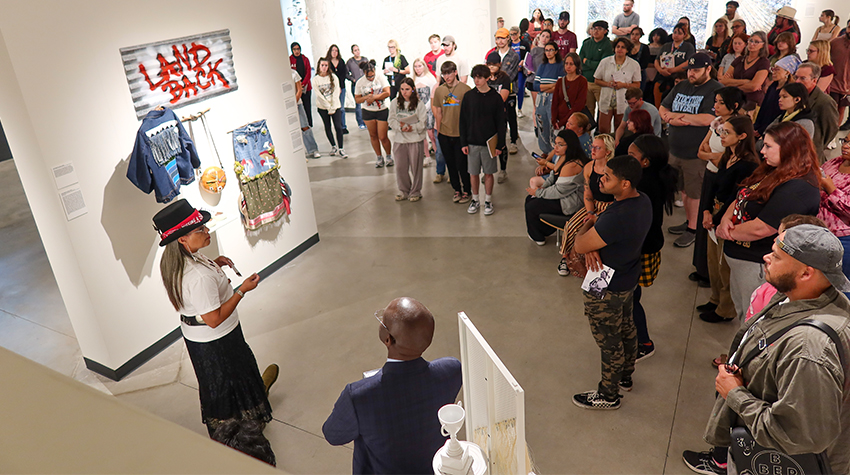
Colonization and westward expansion of American settlers set the stereotype of what Native American dress is known as, which often led to instances of cultural appropriation. This well-known style of clothing is ceremonial Plains dress, categorized by moccasins, leggings, and ponchos made of horse and buffalo skin. Assimilation impacted indigenous fashion practices as well since much of the population was forcibly moved or culturally converted to Western practices.
In the mid-20th century, the emergence of indigenous fashion movements in response to cultural appropriation and commodification became popular across the nation. Lloyd Henri Kiva New (Cherokee) was a pioneer of modern Native American fashion design and is known as the “Godfather of Native Fashion.” He co-founded the Institute of American Indian Arts (IAIA) in New Mexico.4 The challenge of getting recognition from prominent organizations as mainstream artists and becoming a national presence is posed. Textile artists like Bethany Yellowtail (Northern Cheyenne Tribe and Crow Tribe of Montana) and Jamie Okuma (Luiseno, Shoshone-Bannock, Wailaki, and Okinawa) have created their own companies dedicated to their clothing, which have been featured in mainstream Western magazines and museums. Non-Native-owned museums seem to engage a wider audience with collaborative indigenous works and shows.5
Cultural Identity and Authenticity
There are cultural symbols, motifs, and designs associated with indigenous fashion that resonate with Natives and non-Natives alike. There is the issue of Indian-on-Indian cultural misappropriation, according to Nanette Kelley. Some critics claim that there is stolen art between tribes and that Native artists “crossing over” into Western ways of making money through mainstream media goes against Native tradition since these capitalistic tactics were used against Native people.6 While this critique is valid, the world is ever-changing, and the role of indigenous designers and artisans has changed. To reclaim their own cultural identity, artists use their ancestors’ techniques and locally sourced materials to make their art for activism. Amber-Dawn Bear Robe of the Siksika Nation created the Southwestern Association for American Indian Arts and coined the term “Indigenizing” fashion rather than decolonizing it. Bear Robe prefers to indigenize because it entails representation and emphasis on Native Americans and their culture rather than the colonizer’s culture.7
Storytelling also plays a vital part in maintaining authenticity, sustainability, and in indigenous art overall. Nanticoke Lenni Lenape activist and artist Tyrese Gould Jacinto utilizes storytelling in her art as well as her books to continue the tradition of generationally handing down stories. Accessibility is present as well, as children can learn and understand the lessons and values passed down by their Native ancestors. Her art also encapsulates the importance of tradition, in which she has mastered many forms of crafting. She has been featured in many shows and her involvement in events spreads indigenous awareness.8 Similarly, Lehuauakea uses barkcloth and natural pigments to express their stories through traditional means of making kapa. As a Native Hawaiian, their art addresses contemporary issues of colonization and the environment.9
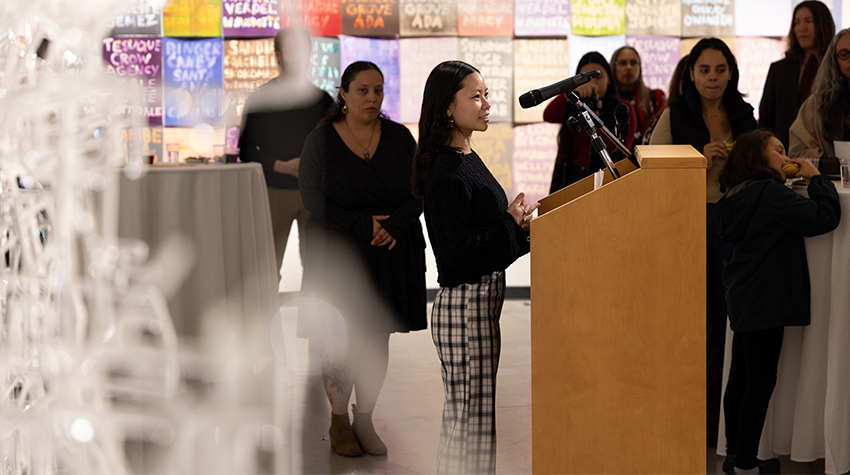
We, as a collective human race, need to take action to create greater awareness and encourage solidarity and inclusion in the fashion industry and beyond. Engaging the public and focusing on Native peoples' perspectives can change the course of the world economically and environmentally.
Sustainability Practices in Native American Fashion
Sustainability can be defined in numerous ways, but it has been popularized and co-opted by white environmentalists, government entities, and businesses.10 In Native American culture, sustainability has been at the forefront for activists and artists alike. Sourcing locally and ethically has been indigenous people’s tradition for centuries, as there is a mutual relationship between the people and the environment. Protecting these resources is significant for future generations to access and survive. For instance, tribes located in the Great Plains collaborated and created the “Water Is Life” movement after the Dakota Access Pipeline was in progress. Water is a sacred resource for Native tribes, as it supplements humans, animals, vegetation, and more.11 Indigenous people from all across the country were able to come together to resist the pipeline, as it would have been a dangerous threat to the local water supply.12 The Dakota Access Pipeline protests inspired the creation of the Mirror Shield Project by artist Cannupa Hanska Luger in 2016. This project brought art and protest together in a sustainable and accessible way for protesters.13
Traditional materials that indigenous populations use depend on location and climate. Artists that use animal hide and plant materials are in danger of resorting to sustainable alternatives because of the mass reduction in available materials due to climate change and capitalism. This is clearly shown in works that use porcupine quills. Invented by indigenous people, quillwork techniques were passed down through generations and ranked among the oldest practices in North America. Unfortunately, deforestation harmed the habitats of porcupines and diminished the population, which led to a decrease in quillwork over the years.14
The incorporation of Earth-friendly practices in contemporary indigenous fashion promotes sustainability, unlike brands that partake in fast fashion. Retailers and online clothing companies produce and promote cheap garments mirroring trends and popular styles that ultimately end up in landfills. This route involves poor labor conditions and a waste of resources. On the contrary, Native fashion is “slow fashion,” which strives to be ethically sourced and not made in abundance. This fashion “is always locally sourced, recycled, upcycled, environmentally conscious, naturally dyed, sustainable, and biodegradable, we prioritize the nature and quality of our sustainable products.”15
Many indigenous artists enter the field of education to teach people about their practices and works. The act of teaching is sustainable in itself because of the information being passed down to others. Lily Hope is a Tlingit Indian, of the Raven moiety who teaches students about her weaving techniques, the spiritual background behind it, and the activism involved in creating such pieces.16
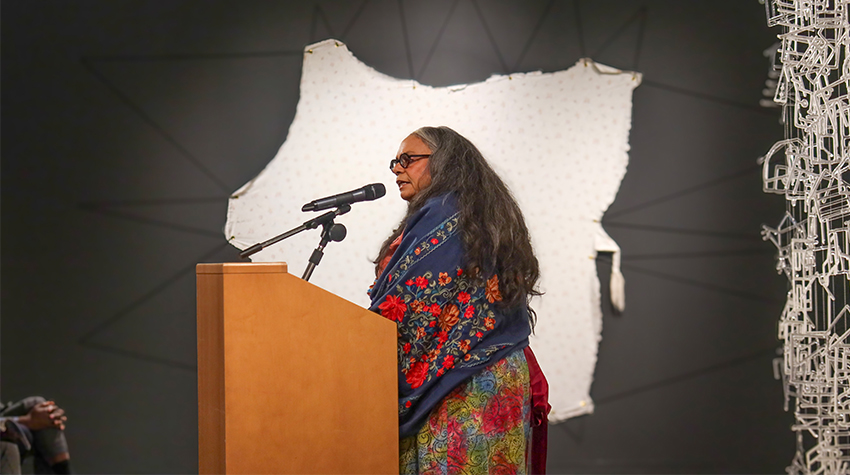
Economic Sovereignty Through Indigenous Fashion
The art of Native American fashion is recognized as a commodity and inspiration for Western designers’ pieces. In 1900s Europe and America, exoticism turned into primitivism and modernism, which took indigenous influence in jewelry, clothing, and more. This, along with stereotypical depictions of indigenous people, led to the cultural appropriation of Native American culture.17 Dressing up as an American Indian for Halloween as a non-Native and portrayals of Native Americans in movies like Pocahontas and Twilight perpetuated the romanticization of indigenous culture. The popularization of moccasins, designs, and patterns originating from Native American culture was reflected in Western fashion throughout the 1900s. Thus, the challenge faced by Native American designers and artisans in the fashion industry is proving authenticity and uniqueness.
Controversy and insensitivity can lead to cultural awareness and “healthy alternatives” to corporate appropriations.18 Despite the challenges of stereotyping and putting indigenous fashion in a box, there is a sense of empowerment through entrepreneurship and community-based initiatives. Brands like “Urban Native Era” and “The NTVS” provide clothing lines for the general public, while raising funds given directly to indigenous people and their communities. These indigenous-owned companies aim to produce clothing for everyone and avoid cultural appropriation while ensuring their own self-determination and sovereignty. The question is whether these indigenous entrepreneurs are being pushed into Western economics as a result. While their brands are being marketed and noticed by the public, it’s a sort of assimilation into American capitalism and Western ways of making a living. In addition, the mass production of goods contributes to American capitalism and contradicts the sustainability aspect. However, supporting small indigenous businesses rather than Amazon or corporations that profit from inauthenticity and cheap labor is still beneficial.
Challenges and Future Directions
To conclude, indigenous fashion encompasses a rich cultural identity, true sustainability, and economic sovereignty, benefitting Native people directly. Recognizing and supporting indigenous fashion is a critical form of resisting capitalism, as it addresses issues of cultural appropriation and exploitation in the fashion industry. There need to be more opportunities for policy advocacy and institutional support for indigenous fashion and communities at large. Museums should showcase more indigenous artists and continue to be the catalyst for change. Advancing indigenous fashion can be used as a tool for resistance and empowerment. Native American peoples have been wronged by colonization and capitalism for centuries, and climate change is a pressing issue perpetually getting worse. We, as a collective human race, need to take action to create greater awareness and encourage solidarity and inclusion in the fashion industry and beyond. Engaging the public and focusing on Native peoples' perspectives can change the course of the world economically and environmentally.
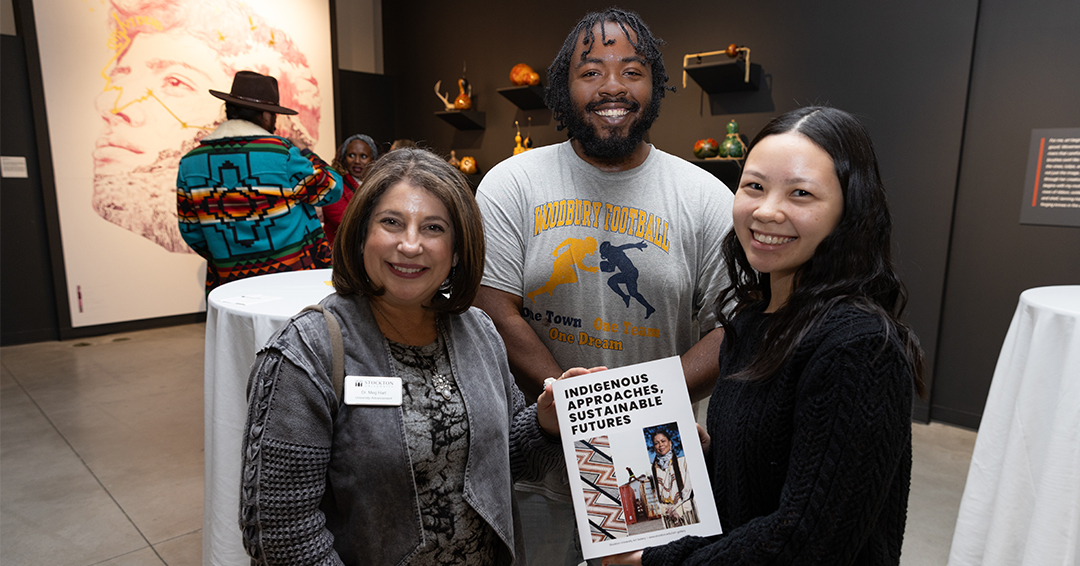
Exploring Indigenous Culture with #StocktonVoices
“Indigenous Approaches, Sustainable Futures” Programs Draw Over 1,000 Visitors
November 14, 2024
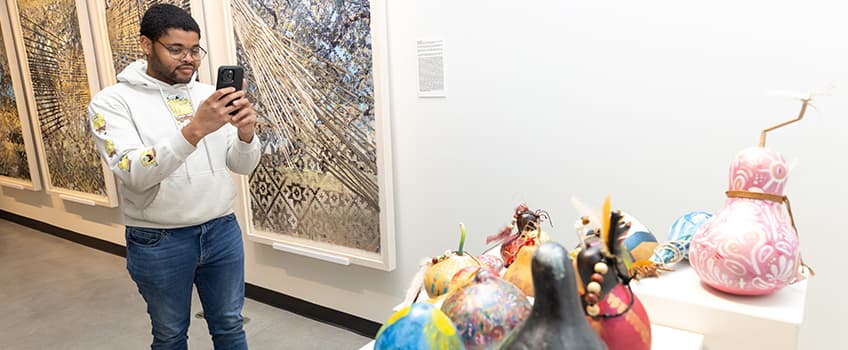
Galloway, N.J. – An exhibition unlike any other in the Stockton University Art Gallery will officially close its doors on Sunday, Nov. 17.
In celebration of the conversations on Indigenous identity that it sparked and the programming that welcomed over 1,000 community members both inside and outside of Stockton to campus, the team behind “Indigenous Approaches, Sustainable Futures” hosted a closing reception on Tuesday, Nov. 12.
The evening began with students presenting the artwork they created in the exhibition’s associated workshops. Pieces included painted gourds from artist Tyrese “Bright Flower” Gould Jacinto’s course, bandanas that were colored with natural dyes and screen-prints of turtles and trees.
Shortly before his performance of a traditional honor song, Ty “Dancing Wolf” Ellis of the Lenapehoking Revitalization Project (LRP) expressed gratitude for being a part of “Indigenous Approaches, Sustainable Futures’” programming on behalf of the project’s youth program, which visited the campus to perform traditional dances for Indigenous Peoples Day on Oct. 15 and participated in some of the associated art workshops.
The photos the youth program took during one of the workshops are currently on display in the gallery, and, according to Ellis, “They lit up seeing their artwork on the wall, and they now have this new fire and passion for art.”
